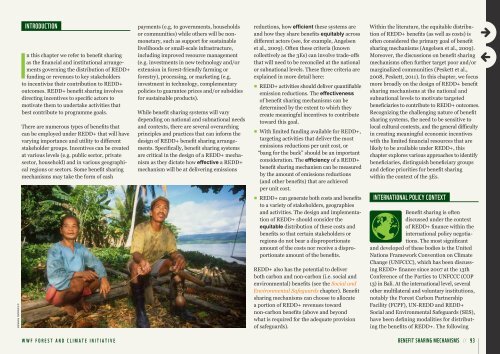WWF Guide to Building REDD+ Strategies
WWF Guide to Building REDD+ Strategies
WWF Guide to Building REDD+ Strategies
You also want an ePaper? Increase the reach of your titles
YUMPU automatically turns print PDFs into web optimized ePapers that Google loves.
© EDWARD PARKER<br />
intRoduCtion<br />
in this chapter we refer <strong>to</strong> benefit sharing<br />
as the financial and institutional arrangements<br />
governing the distribution of <strong>REDD+</strong><br />
funding or revenues <strong>to</strong> key stakeholders<br />
<strong>to</strong> incentivize their contribution <strong>to</strong> <strong>REDD+</strong><br />
outcomes. <strong>REDD+</strong> benefit sharing involves<br />
directing incentives <strong>to</strong> specific ac<strong>to</strong>rs <strong>to</strong><br />
motivate them <strong>to</strong> undertake activities that<br />
best contribute <strong>to</strong> programme goals.<br />
There are numerous types of benefits that<br />
can be employed under <strong>REDD+</strong> that will have<br />
varying importance and utility <strong>to</strong> different<br />
stakeholder groups. Incentives can be created<br />
at various levels (e.g. public sec<strong>to</strong>r, private<br />
sec<strong>to</strong>r, household) and in various geographical<br />
regions or sec<strong>to</strong>rs. Some benefit sharing<br />
mechanisms may take the form of cash<br />
<strong>WWF</strong> FOREST AND CLIMATE INITIATIVE<br />
payments (e.g. <strong>to</strong> governments, households<br />
or communities) while others will be nonmonetary,<br />
such as support for sustainable<br />
livelihoods or small-scale infrastructure,<br />
including improved resource management<br />
(e.g. investments in new technology and/or<br />
extension in forest-friendly farming or<br />
forestry), processing, or marketing (e.g.<br />
investment in technology, complementary<br />
policies <strong>to</strong> guarantee prices and/or subsidies<br />
for sustainable products).<br />
While benefit sharing systems will vary<br />
depending on national and subnational needs<br />
and contexts, there are several overarching<br />
principles and practices that can inform the<br />
design of <strong>REDD+</strong> benefit sharing arrangements.<br />
Specifically, benefit sharing systems<br />
are critical in the design of a <strong>REDD+</strong> mechanism<br />
as they dictate how effective a <strong>REDD+</strong><br />
mechanism will be at delivering emissions<br />
reductions, how efficient these systems are<br />
and how they share benefits equitably across<br />
different ac<strong>to</strong>rs (see, for example, Angelsen<br />
et al., 2009). Often these criteria (known<br />
collectively as the 3Es) can involve trade-offs<br />
that will need <strong>to</strong> be reconciled at the national<br />
or subnational levels. These three criteria are<br />
explained in more detail here:<br />
n <strong>REDD+</strong> activities should deliver quantifiable<br />
emission reductions. The effectiveness<br />
of benefit sharing mechanisms can be<br />
determined by the extent <strong>to</strong> which they<br />
create meaningful incentives <strong>to</strong> contribute<br />
<strong>to</strong>ward this goal.<br />
n With limited funding available for <strong>REDD+</strong>,<br />
targeting activities that deliver the most<br />
emissions reductions per unit cost, or<br />
“bang for the buck” should be an important<br />
consideration. The efficiency of a <strong>REDD+</strong><br />
benefit sharing mechanism can be measured<br />
by the amount of emissions reductions<br />
(and other benefits) that are achieved<br />
per unit cost.<br />
n <strong>REDD+</strong> can generate both costs and benefits<br />
<strong>to</strong> a variety of stakeholders, geographies<br />
and activities. The design and implementation<br />
of <strong>REDD+</strong> should consider the<br />
equitable distribution of these costs and<br />
benefits so that certain stakeholders or<br />
regions do not bear a disproportionate<br />
amount of the costs nor receive a disproportionate<br />
amount of the benefits.<br />
<strong>REDD+</strong> also has the potential <strong>to</strong> deliver<br />
both carbon and non-carbon (i.e. social and<br />
environmental) benefits (see the Social and<br />
Environmental Safeguards chapter). Benefit<br />
sharing mechanisms can choose <strong>to</strong> allocate<br />
a portion of <strong>REDD+</strong> revenues <strong>to</strong>ward<br />
non-carbon benefits (above and beyond<br />
what is required for the adequate provision<br />
of safeguards).<br />
Within the literature, the equitable distribution<br />
of <strong>REDD+</strong> benefits (as well as costs) is<br />
often considered the primary goal of benefit<br />
sharing mechanisms (Angelsen et al., 2009).<br />
Moreover, the discussions on benefit sharing<br />
mechanisms often further target poor and/or<br />
marginalized communities (Peskett et al.,<br />
2008, Peskett, 2011). In this chapter, we focus<br />
more broadly on the design of <strong>REDD+</strong> benefit<br />
sharing mechanisms at the national and<br />
subnational levels <strong>to</strong> motivate targeted<br />
beneficiaries <strong>to</strong> contribute <strong>to</strong> <strong>REDD+</strong> outcomes.<br />
Recognizing the challenging nature of benefit<br />
sharing systems, the need <strong>to</strong> be sensitive <strong>to</strong><br />
local cultural contexts, and the general difficulty<br />
in creating meaningful economic incentives<br />
with the limited financial resources that are<br />
likely <strong>to</strong> be available under <strong>REDD+</strong>, this<br />
chapter explores various approaches <strong>to</strong> identify<br />
beneficiaries, distinguish beneficiary groups<br />
and define priorities for benefit sharing<br />
within the context of the 3Es.<br />
inteRnational PoliCy Context<br />
Benefit sharing is often<br />
discussed under the context<br />
of <strong>REDD+</strong> finance within the<br />
international policy negotiations.<br />
The most significant<br />
and developed of these bodies is the United<br />
Nations Framework Convention on Climate<br />
Change (UNFCCC), which has been discussing<br />
<strong>REDD+</strong> finance since 2007 at the 13th<br />
Conference of the Parties <strong>to</strong> UNFCCC (COP<br />
13) in Bali. At the international level, several<br />
other multilateral and voluntary institutions,<br />
notably the Forest Carbon Partnership<br />
Facility (FCPF), UN-REDD and <strong>REDD+</strong><br />
Social and Environmental Safeguards (SES),<br />
have been defining modalities for distributing<br />
the benefits of <strong>REDD+</strong>. The following<br />
BeneFit SHaRinG meCHaniSmS // 93

















